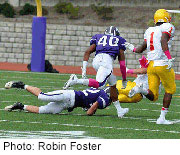
WEDNESDAY, March 6 (HealthDay News) — While repeated concussions are known to cause serious harm to the brain, researchers are now learning that even lesser blows to the head may cause problems later, and an autoimmune response may be the reason why.
Researchers from the University of Rochester Medical Center and the Cleveland Clinic have found that blows to the head that don’t cause concussions may cause a break in the protective blood-brain barrier, allowing substances to leak from the brain into the body. Since those substances — in this case a protein associated with traumatic brain injury — aren’t normally found in the body, the immune system sees them as foreign and attacks them, the researchers explained.
“We looked at a group of football players from three different [college] football teams, and looked at the blood for a certain brain protein called S100B,” explained study co-author Dr. Jeffrey Bazarian, an associate professor of emergency medicine at the University of Rochester Medical Center in New York. “S100B showed up in the circulation after every practice and every game. None of these kids had concussions though. The only way S100B can find its way into the blood is if the gate between the brain and the blood [the blood-brain barrier] is open.”
“We think that just playing football, even without getting a concussion, can open the blood-brain barrier,” said Bazarian.
If this protein is repeatedly released into the bloodstream, the body’s immune system will eventually take notice of the protein. And, because it’s a protein not normally seen in the blood, the immune system may see it as a foreign invader, much like bacteria or viruses. If the immune system feels it’s a dangerous foreign substance, it will create antibodies against the protein, presumably to destroy it, which is what these researchers found.
That temporary opening created in the blood-brain barrier might also allow the antibodies into the brain, where they would target S100B.
But, Bazarian added that the researchers only know for sure that there’s an immune response. They really don’t know whether it’s a damaging response or even a protective one at this point.
The issue of repeated blows to the head during play came to the forefront last year after the former National Football League star linebacker Junior Seau killed himself. It was later found that he had a catastrophic brain disorder thought to be caused by repeated blows to the head.
Because so many athletes suffer less serious hits to the head, Bazarian and his colleagues wanted to assess how these types of hits might affect the brain and body.
Blood samples were collected from 67 players before and after games. The number of hits to the head was assessed through video review, and asking players how many times they’d been hit in the head. Ten of the players also underwent brain imaging.
They found that the more hits to the head a player took, the higher the levels of S100B. They also had higher levels of the antibodies. Players who usually sat on the bench had lower levels of these markers.
Researchers also noted changes in brain imaging that correlated with higher levels of S100B, according to the study.
“This is yet another piece of information showing that sub-concussive blows can potentially be bad. It might not be the injury itself, but the immune response that happens after,” said Bazarian, who added that if other studies confirm these findings, it might be possible to develop a vaccine against these antibodies.
But, he said, a lot of research remains to be done. “This is a very first step. We need to know if there are other proteins released into the blood. And, is there a genetic susceptibility that causes an exaggerated response in some people? This is all work that needs to be done,” he said.
Dr. Steven Galetta, chair of neurology and co-director of the concussion center at NYU Langone Medical Center, agreed. “This is a potentially interesting finding that could spur further investigation,” said Galetta.
“It was a small [group of people studied], and I think there will be debate about how these sub-concussive hits were defined and recorded. There may be more accurate devices that could record each hit and the force of each hit, instead of using video and the athlete’s opinion,” he said, noting that some of these players may, in fact, have had concussions and not known it.
“This is a very important topic, and the more research, the better. But, right now, we’ve in the very early stages, and this is very preliminary,” said Galetta.
Results of the study were published March 6 in the journal PLOS One.
More information
Learn more about head injuries, sports and what you can do to prevent head injuries from the American Association of Neurological Surgeons.

